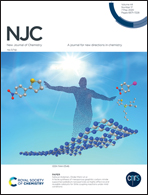Strong proton-shared hydrogen bonding in a methyl imidazole⋯HCl complex: evidence from matrix isolation infrared spectroscopy and ab initio computations†
Abstract
Methyl imidazole (M-Imid)⋯HCl (1 : 1) complexes were studied using matrix isolation infrared spectroscopy and ab initio computations. Computations using the MP2 level of theory with the aug-cc-pVDZ basis set predicted three complexes, where the global minimum had a strong hydrogen-bonded N⋯H⋯Cl interaction with a binding energy of ∼12 kcal mol−1 (complex A). The first local minimum had an H⋯π interaction (complex B) and the second local minimum (complex C) was stabilized through combined hydrogen, halogen and pnicogen bonding (with a nitrogen atom as the pnicogen) interactions. Of the three complexes, the hydrogen-bonded complex A alone possesses experimental significance. Experiments were performed by co-depositing M-Imid and HCl separately in an N2 matrix at a low temperature of ∼12 K. The annealing of the low temperature matrix encouraged the formation of M-Imid–HCl complex A, which was subsequently probed using infrared spectroscopy. Experimentally, the vibrational shift of ∼1720 cm−1 was observed for the N2 matrix, while harmonic frequency calculations indicated a shift of 1063 cm−1 in the H–Cl stretching region of the strong hydrogen-bonded complex A. The inclusion of anharmonicity in the calculations red-shifted the H–Cl stretching frequency further down to 1650 cm−1, which was almost close to the experimental value. It is inferred from this large experimental red-shift of the stretching frequency of the proton donor that proton-shared hydrogen bonding is facilitated in the M-Imid–HCl system experimentally. Using atoms in molecules, energy decomposition and natural bond orbital analyses, the uniqueness of this strong proton-shared hydrogen bonding is established with respect to conventional hydrogen bonding.



 Please wait while we load your content...
Please wait while we load your content...